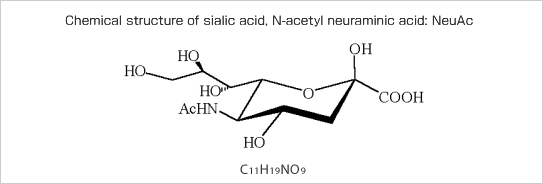![]()
The functions of sialic acid
Sialic acid is one of the sugars (acidic sugars) that are present in the sugar chain terminal on a cell surface, being present in breast milk and chicken eggs, besides human cells. The functions of sialic acid can be briefly explained as, "mediation of binding of some substances to cells with its presence on cell surfaces."
The sialic acid-containing sugar chains play a role in functions, such as inter-cellular signal transduction and "receptors (receptor-like functions)" for binding of some substances to cells. For example, the sugar chains are greatly involved in the viral and bacterial infection of cells.

Major functions of sialic acid and uses thereof
| Pharmacological functions: | Leaning ability-improving effect |
|---|---|
| Infection-preventive effect | |
| Expectorant effect | |
| Therapeutic effect on amyotrophy |
| Uses: | Reagent for research use |
|---|---|
| Raw material for pharmaceutical products | |
| Raw material for diagnostic agents | |
| Virus filter | |
| Virus censor |
Baby and sialic acid
As mentioned before, sialic acid is present in breast milk, and it has been reported that the content of sialic acid is particularly high in the foremilk until day 10 after delivery. This plays important roles in the health maintenance of infants, such as supplementation of undeveloped immune function in neonates, or prevention of viral infection that has been considered as a major cause for neonatal symptoms such as diarrhea, etc.
In addition, sialic acid is contained at a particularly high content in the brain and the central nervous system, and its content has been said to be the highest in infants. This is because sialic acid plays a very important role in cerebral development.
Unique manufacturing of sialic acid

High-performance
liquid chromatography
The method for the extraction is mainly from the natural sources of animal origin (swallow's nests, cow milk, and chicken eggs) or the fermentation method using some sort of bacterial strain of Escherichia coli has been adopted for manufacturing sialic acid, the versatile use of which is expected. However, there have been limitations in the manufacturing from the raw materials derived from such natural sources from the aspects of supply quantity and cost.
The technology of large-scale manufacturing of sialic acid has been established by the original research at SANYO FINE CO., LTD. enabling a large-scale supply. The purity of sialic acid manufactured by this method is higher compared to that obtained by other methods, giving a very high-quality product.






